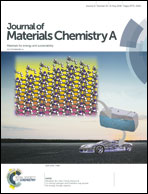Construction of microfluidic-oriented polyaniline nanorod arrays/graphene composite fibers for application in wearable micro-supercapacitors†
Abstract
Herein, we propose a high-performance micro-supercapacitor (micro-SC) based on microfluidic-oriented core-sheath polyaniline nanorod arrays/graphene (PNA/G) composite fiber electrode where sheath polyaniline nanorod arrays are in situ wrapped on graphene core. The micro-SCs display excellent electrochemical performances including large capacitance (230 mF cm−2), high cycling stability (86.9% retention after 8000 cycles), long-term bending durability and high energy density (37.2 μW h cm−2). This higher performance of the micro-SC is distinctly associated with the core–sheath structure of PNA/G fiber, along with high electrical conductivity (18 734 S m−1) and ion riched pseudo-capacitance. We further integrate micro-SCs into flexible substrates to successfully power various electronics such as light-emitting diodes (LEDs), monochrome displays and smart watches. Our finding may open an avenue for microfluidic design of electrochemically active electrodes and may guide the development of next-generation wearable electronics.



 Please wait while we load your content...
Please wait while we load your content...